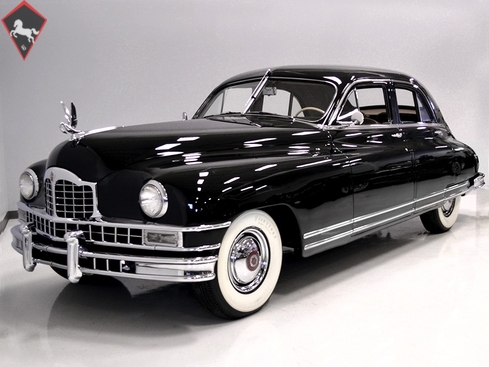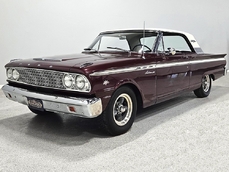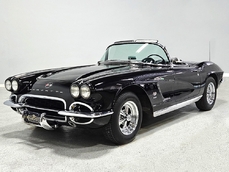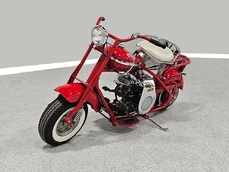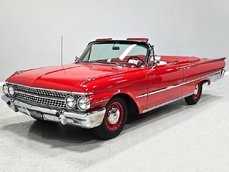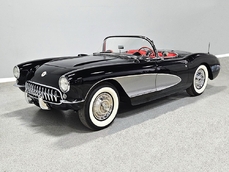Packard Custom Eight 356 cubic inch straight-8 1948
Allgemeine Beschreibung :
Packards are special. That’s all there is to it. They are the #1 most popular marque with the Classic Car Club of America and from first car in 1899 to last in 1958, they remain on many enthusiasts’ must-have list. The reasons are many: quality, styling, prestige, and, yes, reputation. Regardless of which year and model you prefer, it is likely a high-quality car with superlative driving manners compared to its peers and styling to make it stand out. And while some of that is subjective, there is nobody who believes that a Packard is an ordinary car.
Which brings us to this 1948 Packard Custom Eight touring sedan. It was Packard’s first all-new design following the war, a smooth look which, if not beloved, is handsome and imposing from any angle. The Custom Eight was the top-of-the-line model in 1948, sitting on a long 127-inch wheelbase and powered by what is arguably Packard’s best engine, the 356 cubic inch straight-8 introduced in 1940. Those extra inches in the wheelbase make this big sedan look formidable and elegant, and with most of the added length showing up ahead of the firewall, the proportions are dramatic. Finished in black, it looks expensive from any angle and the high-gloss finish seems appropriate on a car that cost as much as a Cadillac in 1948. This particular car was treated to a quality frame-on restoration about six years ago, and that included a full cosmetic makeover that results in a glittering 4-door that whispers to you about a forgotten age. The clean, straight bodywork strongly suggests that this was never a rusty car and all four doors open and close with a solidity that is hard to describe but very impressive in person. The two-way hood opens from either side and fits quite well and the long strips of chrome along the rocker panels don’t permit any carelessness with final assembly, and you can see that they line up just right.
And speaking of chrome it appears that most of the bright trim on the car was restored at the same time, from the traditional Packard “eggcrate” grille to the matching tail panel out back. Wrap-around bumpers provide excellent protection but also become an integral part of the styling, leading into those trim strips that I mentioned earlier. There Custom Eight also included the bright strip of chrome at the beltline, which swoops dramatically down around the trunk lid. The only possible demerit might be some light pitting on the cormorant hood ornament, but you’ll be hard-pressed to see it from even a foot away. This car shows many signs of considerable investment in its cosmetics.
Likewise, the beautiful brown broadcloth interior was fully restored and it’s simply stunning. Sliding behind the wheel is a special occasion in this car and the wonderfully comfortable seats feel like they envelop you as you settle in. The button-tufted patterns are correct, offering pleasing details without being too ornamental, and the contrasting white piping adds definition. You’ll note the door panels were accurately reproduced as well and the carpets are new throughout. Garnish moldings and the dashboard were all refinished with correct woodgraining and that big, ornate steering wheel was re-cast in correct cream-colored plastic. Gold-faced instruments are fully functional save for the clock, which we believe is merely disconnected, not broken, but we have not investigated. Secondary controls are arrayed in a series of small buttons under the speaker grille, and you’d do well to familiarize yourself with them before setting off, because their markings are difficult to see on the roll. Ventilation controls are underneath, a series of four ivory-colored knobs that mange fresh air, defrost, heater functions. There’s also a larger knob near the steering column that controls the overdrive. The original radio powers up and hums but does not pull in any stations, which isn’t unusual for radios of this period, but it does have a neat look. In back, there’s massive legroom and more ornate moldings and bright chrome details, along with a fold-down armrest that makes it feel almost sinful to be there. The large trunk is equally well-appointed, offering matching tan carpets and a full-sized spare with jack assembly.
With the demise of the Twelve in 1940, Packard introduced a new 356 cubic inch straight-8 powerplant that was more than a match for the biggest engines of the 1930s. With nine main bearings, it’s impossibly smooth and with legendary Packard torque behind it, it moves the biggest cars without effort. We believe this engine was rebuilt when the car was restored, but then it was driven and enjoyed so it shows a few minor signs of use. The Packard Gray engine enamel still looks clean and aside from a few touch ups (that look far more noticeable in our photos with a flash than they do in person) it shows well. A recent tune-up and choke adjustment means it runs well and pulls the big sedan around with real authority. Aside from an electric fuel pump that really isn’t even needed except for priming, it remains completely stock with no questionable modifications. The Stromberg downdraft carburetor still fires using the accelerator-mounted switch, a six-volt generator makes the electricity, and it never seems to get too warm or fussy, even idling on a warm day. The wiring harness is new, there are proper decals in the usual spots, and the only other item that seems to not belong is the coil, but correct reproductions are readily available.
The three-speed manual transmission shifts so smoothly and effortlessly that we believe it has also been rebuilt. Clutch action is light and the shifter moves with only your fingertips, so almost anyone should feel comfortable behind the wheel. The overdrive is invisible in normal operation, so we just leave it on all the time, and the big car gathers momentum with ease on the road. The brakes are powerful and the suspension rides like a massive luxury car should, so don’t expect sports car levels of handling. On the other hand, if you’re looking for a first-class tour car, few cars are better suited to consuming long stretches of highway than this big Packard. The undercarriage is largely original (this was a frame-on restoration, remember) but shows no indications of rust or other maladies. Yes, there’s surface scale, but knowledgeable hobbyists will recognize that it is cosmetic only and the floors and rockers are in excellent condition (actually, most of what appears to be surface rust under the car is actually dirt). Recent brake lines and shocks mean that it drives like it should and the single exhaust has a muted 8-cylinder hum that suits the car perfectly. 15-inch steel wheels with hubcaps are correct and ride inside a set of large 8.20-15 Firestone wide whites that look great and have lots of life left in them.
We like this car a lot more than we expected to. It’s handsome, powerful, and someone clearly spent a great deal of money restoring it to this level. It is not a show car, but if you want one of the best road cars of the late-40s, you can scarcely do better than a big Packard like this.
http://www.harwoodmotors.com/vehicles/inventory_details.php?id=722
1948 Packard Custom Eight 356 cubic inch straight-8 is listed verkauft on ClassicDigest in Macedonia by for Preis nicht verfügbar.
Fakten der Auto
Karosserietyp : Auto Marke : Packard Modell : Custom Eight Ausführung : 356 cubic inch straight-8 Hubraum : 0.0 Modelljahr : 1948 Karosstyp : Kombi Lage : Ohio
Verkauft
Angaben Zum Verkäufer
Verkauft
Other cars listed for sale by this dealer
über Packard
Packard: Eine umfassende GeschichteFrühe Jahre und Stiftung:
Gründung: Die Packard Motor Car Company wurde 1899 in Warren, Ohio, von James Ward Packard, William Doud Packard und George Lewis Weiss gegründet.
Pionierluxus: Packard produzierte zunächst hochwertige Automobile und wurde zum Synonym für Luxus, Handwerk und technische Exzellenz.
Bemerkenswerte Erfolge und Beiträge:
Packard Twin Six: Das 1916 eingeführte Auto wurde Packard als Premier Luxury Automobile Marke eingerichtet.
Modelllinienerweiterung: Packard hat seine Aufstellung mit verschiedenen Modellen erweitert, darunter Limousinen, Coupes, Cabrios und Limousinen, die an wohlhabende Kunden geliefert werden, die Eleganz und Leistung suchen.
Engineering Innovations: Die Marke führte mehrere Innovationen ein, z.
Zehn historisch bedeutende Modelle mit technischen Spezifikationen:
Packard Twin Six (1916):
Motor: 7.3L V12 Motor.
Leistung: rund 85 PS.
Packard acht (1930-1938):
Motor: Straight-8 Motor mit verschiedenen Verschiebungen.
Leistung: reicht zwischen 90 und über 130 PS.
Packard Super Eight (1939-1951):
Motor: Straight-8 Motor.
Leistung: Produktion zwischen 130 und 180 PS.
Packard One-Twenty (1935-1942):
Motor: Straight-8 Motor.
Leistung: ca. 100 bis 120 PS.
Packard Clipper (1941-1957):
Motor: V8 Motor.
Leistung: reichen von 135 bis 185 PS.
Packard Caribbean (1953-1956):
Motor: V8 Motor.
Leistung: variiert zwischen 275 und 310 PS.
Packard Patrician (1951-1956):
Motor: Inline-8- und V8-Motoren.
Leistung: reicht von 150 bis 180 PS.
Packard Hawk (1958):
Motor: V8 Motor.
Leistung: Erzeugt um 275 PS.
Packard Executive (1956-1958):
Motor: V8 Motor.
Leistung: variiert zwischen 240 und 290 PS.
Packard Predictor (1956):
Motor: Konzeptauto präsentieren Design und Technologie.
Leistung: Prototypmodell.
Vermächtnis und Einfluss:
Qualität und Eleganz: Packard wurde wegen seiner außergewöhnlichen Verarbeitungsqualität, des raffinierten Stylings und seiner Luxusmerkmale verehrt, die häufig mit europäischen Luxusmarken wie Mercedes-Benz auf A-A-Niveau berücksichtigt wurden.
Produktionsende: Die Marke hatte in den 1950er Jahren finanzielle Kämpfe, was zu ihrer Fusion mit Studebaker und letztendlich Ende der 1950er Jahre führte, was das Ende einer Ära in amerikanischen Luxusautomobilen kennzeichnete.
Packard hinterließ ein dauerhaftes Erbe in der Automobilindustrie, symbolisierte Eleganz, technische Exzellenz und ein Engagement für Luxus, das weltweit von Autoenthusiasten bewundert und respektiert wurde.
